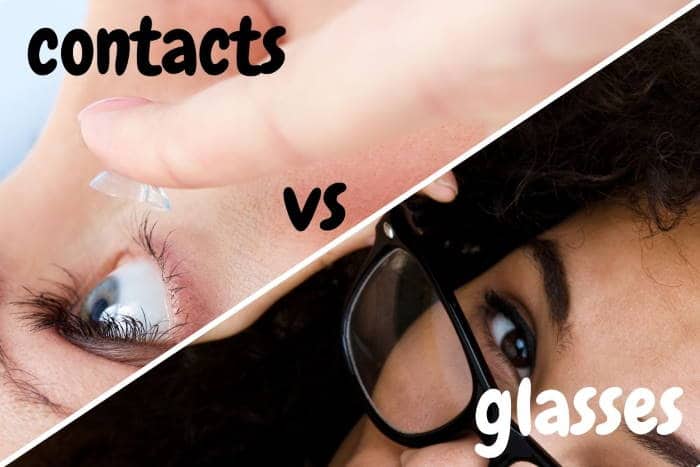
(This page contains affiliate links. OGR may receive compensation if you click a link and make a purchase.)
Trying to decide if contacts or glasses are better for you? Both options have distinct benefits and drawbacks, but you’re not limited to one or the other. Many people switch back and forth between the two depending on their daily activities and eye condition.
Let’s examine them both, shall we?
Glasses
- Pros
- Easy To Wear/Care For
- Cheaper Than Contacts
- Can Be A Fashion Accessory
- Can Get Light-Transitioning Lenses
- Cons
- Lenses Can Fog Up In Cold Weather
- High Rx Can Result in Distorted Peripheral Vision
- Extra Bulk On Face
- Harder To Play Sports Or Active Pursuits
Eyeglasses have been around in one form or another for several centuries, and are the usual go-to when you first need vision correction. They’re easy to put on and take off, and don’t require a ton of maintenance or care.

Many people find them to be a nice addition to their look, and with the plethora of frame shapes, sizes, and colors, it’s hard not to find a pair you’ll like. You can even have a few different frames to go with different outfits and looks.
If you’re active in sports or other physical pursuits, wearing glasses can get a bit dicey. They can also get kind of heavy if you’ve got a high prescription, but lots of thinner lens options are available to reduce the coke bottle effect.
You can find eyeglasses at all budgets from as low as $6.95 frames to high-end designer specs that cost thousands of dollars.
Of course, the most important part about eyeglasses are the lenses. Here are the 3 main types of lens corrections:
Single-Vision
Single-vision lenses correct for one field of vision – generally either nearsightedness or farsightedness. The entire lens is produced to give you clear distance or near vision, depending on which refractive error you have.
Single-vision lenses can also be used to correct astigmatism.
Bifocals/Trifocals
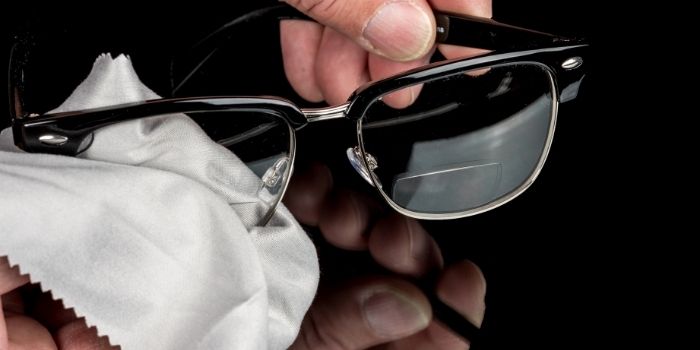
If you’re over 40, you may notice that your near vision is harder to focus. This is due to a condition called presbyopia and is the main reason you see older adults wear reading glasses or bifocals.
Unlike single-vision lenses, bifocals contain two separate lens powers. The upper section of the lens is meant to aid the wearer in seeing distance clearly, while the bottom part is designed to facilitate reading and near-vision activities.
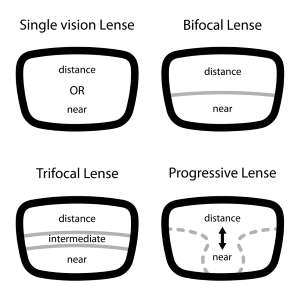
On top of this, there are also trifocals, which correct 3 ranges: near, intermediate, and distance.
The top portion is for distance viewing, the middle area for intermediate ranges, and the bottom for reading.
Bifocals are identified by a distinct line where the reading lens begins, resulting in a sudden change of focus when looking through the magnifying area.
Progressive lenses
Progressive lenses are quite similar to trifocals in that they have 3 different focal corrections from top to bottom. However, progressives provide a gradual transition without the lines so that your focus doesn’t abruptly change from distance viewing to near or intermediate vision.
Many people prefer progressive lenses since they don’t announce to the world that you’re aging the way bifocals do. The gradual transition can also be less jarring and more closely mimic your natural vision.
Contacts
- Pros
- Unobstructed Peripheral Vision
- Doesn't Cover Up Your Face
- No Fogging or Splattering In Weather Conditions
- Easy To Play Sports And Wear Non-Rx Sunglasses
- Cons
- Higher Maintenance/Cleaning Required
- More Expensive Than Glasses
- Increased Risk Of Eye Infections If Not Handled Properly
- Can Exacerbate Dry Or Irritated Eyes
Contact lenses have been around a lot longer than you might think. Of course, today’s technologies make contacts much better for your eye health and more comfortable to wear than the early versions.
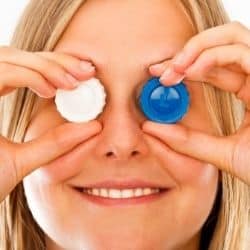
The main benefit of wearing contacts is the fact that it’s like having perfect vision without wearing an additional device on your face.
Only those who look closely at your eyes will know you’re wearing any sort of eyewear, and they give you the freedom to do nearly any activity without worrying about glasses falling off.
If you’re like me, you’ll also appreciate not having dent marks on your nose or behind your ears where the weight of glasses can put pressure.
On the other hand, contacts are usually more expensive as it involves a separate fitting from your eye exam, plus continual replacement of disposable lenses.
There’s also a learning curve as a beginner trying to insert and remove your lenses.
In general, contacts are used for correcting near or farsightedness, but there are multi-focal contacts and lenses that correct astigmatism too.
The most common types of contact lenses you’ll encounter are:
Soft Lenses
As the name suggests, soft contact lenses are not rigid pieces of plastic. They hold more water, are more comfortable on the eye, and are the most commonly prescribed for contact lens wearers.
In terms of material construction, they are made from hydrogel or silicone hydrogel. Regardless of the shape of your eye, they adapt and mold to the surface of the eye easily.
Soft contacts are disposable lenses, ranging from monthlies to bi-weeklies, or even dailies.
This means you’ll need to purchase new lenses every 6 to 12 months, depending on your supply and usage.
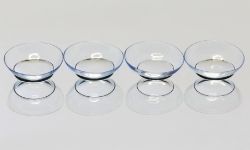
Besides being more comfortable than hard contacts, soft lenses don’t fall out as often, and daily lenses don’t require routine cleaning.
Hard Lenses
Hard contacts are made of a more rigid plastic and are smaller than soft contacts (they fit just over the cornea, where soft lenses extend to cover some of the white area). These lenses can be reused long-term with proper care and if your prescription doesn’t change.
Hard contacts used to have a bad reputation in the past, as the more primitive variants did not allow the eye to breathe. Modern versions allow more oxygen to permeate, almost eliminating that problem.
Unlike soft contacts, hard lenses require a more extensive fitting process because they are custom-made for your eyes.
Overall, hard contacts are ideal for people who want to prevent their vision from degenerating further or have odd eye shapes (including astigmatism) unsuited for soft contacts.

Most people will initially feel hard contacts on their eyes when first starting out, so there’s more of an adjustment period to get used to them. They often provide better optics than soft lenses though, and the reusable lenses can save you money in the long run.
Things To Consider
Lifestyle

Depending on your job and hobbies, your lifestyle may be more active or sedentary. Glasses are both an accessory and a corrective device, designed to be worn as often as needed.
Given the fact that they sit directly on your face, they can make physical activity like running, biking, or swimming less practical.
Or, you may just be clumsy and prone to dropping or mishandling them. Aesthetically, some people feel that wearing glasses makes them unattractive, making contacts a good option.
Aside from physical activity, you should also consider your level of comfort in touching your eyes and commitment to nightly removal and cleaning. If you’re squeamish about putting something into your eye, contacts may not work out for you.
Budget

Budget-wise, there’s really no comparison: glasses are almost always cheaper. Provided your prescription doesn’t change and you don’t break your frames, you can wear the same pair of glasses for years.
As we’ve seen, soft contact lenses are disposable, so you’ll need to continue purchasing new lenses each year.
The more disposable the lens (i.e., daily vs. bi-weekly or monthly), the more expensive they’ll be.
For comparison, let’s say you purchase a new pair of prescription glasses for $150 (very doable if you purchase online). With contacts, you’ll likely pay around $300 or more for an annual supply of bi-weekly lenses, plus the cost of contact lens solution.
Eye Conditions
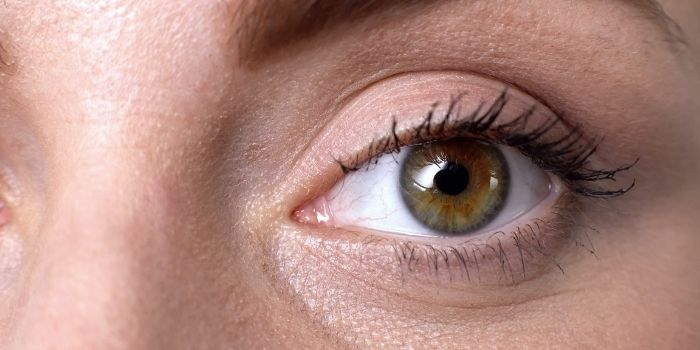
Without a doubt, wearing contact lenses increases the potential for infections since they sit directly on the surface of the eye.
For this reason, it’s incredibly important to wash your hands thoroughly with soap and water before you insert or take out your contacts.
In addition, if you are suffering from dry eye, contacts are known to exacerbate the condition, making your eyes feel gritty and uncomfortable.
If you do suffer from dry eye, it doesn’t necessarily mean you’re stuck wearing glasses. Many people alternate between wearing glasses and contacts depending on how their eyes feel on a given day.
FAQs
Are contact lenses safe?
Yes, with proper cleaning and hygiene, contact lenses are quite safe to wear.
Modern lenses are made from a special silicone hydrogel that allows the eye to get more oxygen and breathe. You should still take them out nightly though unless you have extended wear contact lenses.
If you’re good about removing and cleaning your lenses daily, you should have no problem.
Is it bad to wear contacts daily?
If you’re not experiencing discomfort and keep up with removing and cleaning them daily, it’s perfectly fine to wear contacts everyday.
Just be sure to replace disposable lenses in the correct time frame. That is, if you’re wearing bi-weeklies, don’t use them for a full month in an effort to save money.
Dailies are much thinner and will disintegrate faster than bi-weekly or monthly disposables, so they should be thrown out after one use.
How do I transition from glasses to contacts?
The main concern while switching is to avoid eye strain or damage. The first and most important habit you have to pick up is routine cleaning: both the lenses and your hands.
Skipping out on daily cleaning and proper storage can introduce bacteria and infection if you’re not careful.
Next, don’t attempt to transition fully on the first day. Wear your contacts for a few hours at first, and, if they’re comfortable, increase the time in them the next day. This facilitates adaptation and prevents eye irritation.
Can I order contacts with my glasses prescription?
No, contact lens prescriptions require a separate fitting from your regular eye exam. If you get an eye exam and contact lens fitting at the same time, you should receive both a glasses prescription and a contact prescription from your eye doctor.
Are contacts or glasses better for astigmatism?
Both options are well-suited for correcting astigmatism (when your eye is shaped more like a football than a ball). Contacts are generally better for correcting mild to moderate astigmatism unless you get toric contacts.